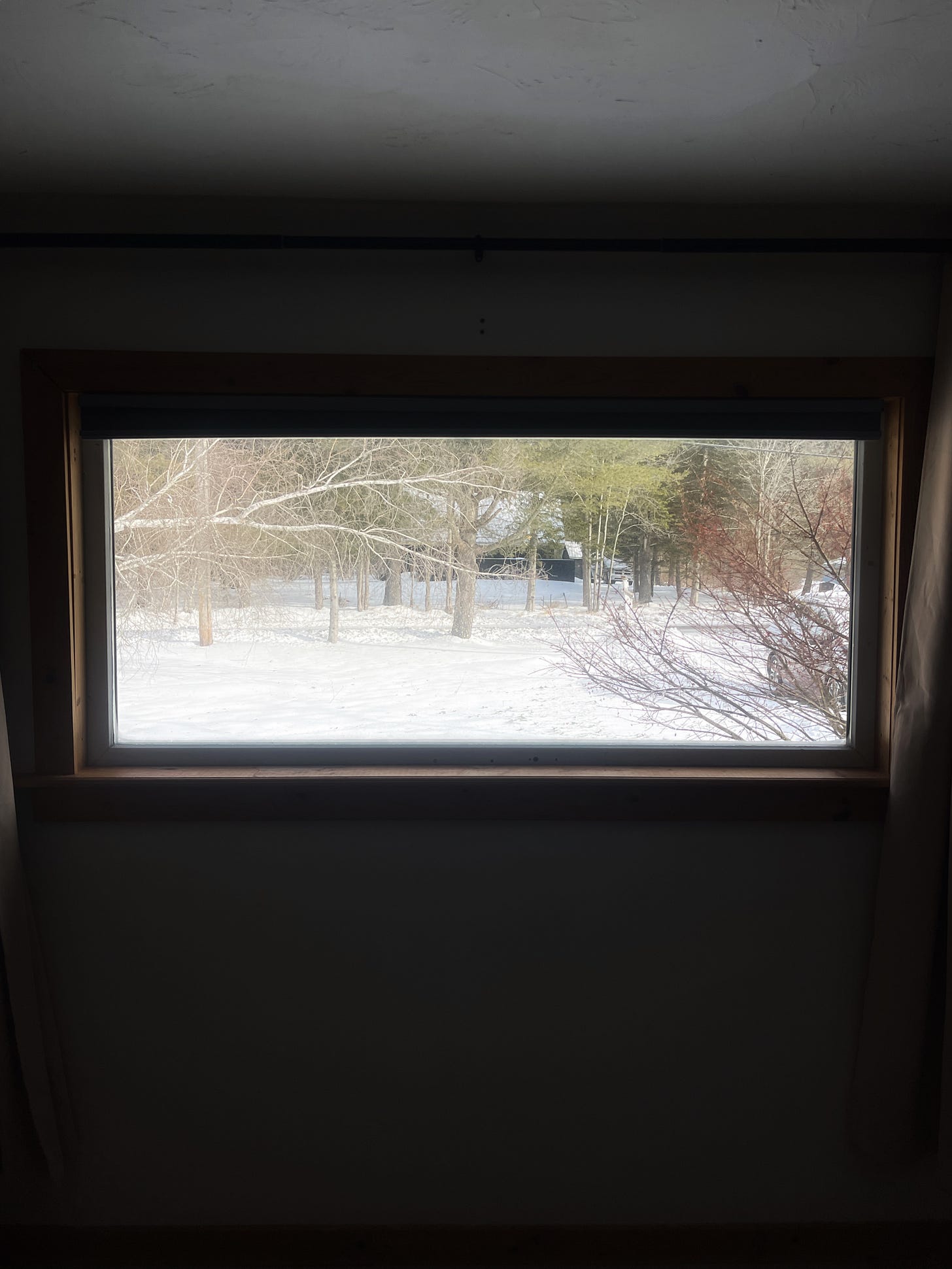On Monday, we drove home from New York where we’d spent the holiday weekend in the snowy Catskills.
As we drove down the mountain, I leaned hard toward Jonathan sitting in the driver’s seat, as if by shifting my weight I could angle us away from the sheer drop just visible beyond the guardrail.
Guardrails on mountain roads never seem quite tall enough.
Once we’d made it down to the highway, we found ourselves in a traffic jam we couldn’t quite comprehend. It was only as the flashing lights of emergency vehicles came into view that we realized we were caught in a classic “gaper’s delay.” There was no obstruction on our side of the road, but cars were slowing to get a look at what had happened—perhaps overnight—on the other side of the divided highway.
While Jonathan kept his eyes on the road, I told him what I saw: a crane slowly lifting a truck from where it had careened off the road and down. How far? I couldn’t see, but as we passed the scene I noticed just how far from the crash site itself the guardrails had broken open.
That truck must have flown through the air for a long while before it crashed into the ground.
This week, I spent time exploring the website of a conference a friend had recommended.
It looked like a beautiful, meaningful event, but I got a little stuck on the “about us” page. Twenty years ago, I would not have blinked an eye. A belief statement that focused on the Bible as infallible and inerrant was all I knew back then.
I’m not sure I had ever even read the historic creeds, known today as the Apostles Creed, the Nicene Creed, and the Chalcedonian Creed. But reading this website, I thought of them with gratitude.
The creed so-called because it expresses the teaching of the apostles is one I affirm daily during the morning prayer office. The Nicene Creed is one we declare as a church as part of our Sunday liturgy.
Learning, praying, and living with the historic creeds has only emphasized—for me—the limitations of many contemporary diy versions. To emphasize the inerrancy and infallibility of books that do in fact show signs of their copying and transmission ignores the human fingerprints on these texts, and it is the remarkable consistency of these manuscripts across many hundreds of years that helps make them incredibly persuasive as Scripture. By insisting on “inerrancy,” the Christian faith begins to seem as if it rests on a thoroughly modern and materialist framework, as if what proves our faith is the historicity of our documentary evidence. Don’t get me wrong: the documentary evidence for the astonishing Christian story is very strong, but faith in the death, resurrection, and ascension of God’s own Son does not rest on a scholarly analysis of a particular document.
Diy “belief statements” also trade the invitational quality of narrative for phrases that read more like shorthand formulas. Modern belief statements are often defensive. They seem intended to define certain doctrinal positions rather than invite Christians to feed on the words of Scripture and digest its wisdom.
The historic creeds were crafted by the spiritual leaders of the early church meeting together and intentionally seeking the guidance of the Holy Spirit. To disregard their work is to disregard the work of God’s spirit in the church. It is a kind of pride to assume we know better and can—on our own—do better.
The creeds clarify the boundaries of the Christian faith.
We can think of them as guardrails protecting us from error. We can also think of them as garden walls.
A walled garden is a sheltered, protected place in which abundant and diverse life can flourish. With a wall, we have comfort and safety. There is no need for every individual to properly ask and answer every theological question. Instead, wisdom can be passed from generation to generation. But walls also encourage creativity, play, exploration, growth.
There is a lot of open ground between the lines of a creed.
You might even call each one a spacious place.
The Nicene Creed
We believe in one God,
the Father, the Almighty,
maker of heaven and earth,
of all that is, seen and unseen.
We believe in one Lord, Jesus Christ,
the only Son of God,
eternally begotten of the Father,
God from God, Light from Light,
true God from true God,
begotten, not made,
of one Being with the Father.
Through him all things were made.
For us and for our salvation
he came down from heaven:
by the power of the Holy Spirit
he became incarnate from the Virgin Mary,
and was made man.
For our sake he was crucified under Pontius Pilate;
he suffered death and was buried.
On the third day he rose again
in accordance with the Scriptures;
he ascended into heaven
and is seated at the right hand of the Father.
He will come again in glory to judge the living and the dead,
and his kingdom will have no end.
We believe in the Holy Spirit, the Lord, the giver of life,
who proceeds from the Father and the Son.
With the Father and the Son he is worshiped and glorified.
He has spoken through the Prophets.
We believe in one holy catholic and apostolic Church.
We acknowledge one baptism for the forgiveness of sins.
We look for the resurrection of the dead,
and the life of the world to come. Amen.






I have often looked back and marveled at the clarity and beautiful simplicity of the Apostles and Nicene creeds and at the mystery of how those words shaped me at age 14. I had the privilege of a wise teacher who helped me not just memorize by rote, but grasp as much as a child can, the tenets of faith I was about to publicly profess. Indeed they have been sturdy guardrails as this pilgrim has traveled many winding roads.